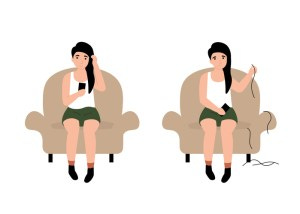Trichotillomania
"Don’t let your mind bully your body."
Do you remember when you were reading, studying for a school exam, or writing a term paper? Were you unconsciously twirling, twisting, and pulling your hair until the strands fell out?
The ancient origins of the word, Trichotillomania come from Greek root terms meaning "hair," "pulling," and "mania," or madness. There is nothing mad or crazy about this little-understood disorder. Today, psychiatry and medicine define it as an impulse control disorder.
I have worked with people with Trichotillomania. They are also known as "tricksters," but nothing is humorous about this disorder. It is a disorder also known as hair-pulling. "Trichotillomania is repetitive twisting and twirling of the hair. The hair loss is usually in a well-defined area with shortened, broken-off hairs and early hair regrowth. The scalp is the most common site, but eyelashes and eyebrows may also be involved. The hair loss can also be patchy and poorly defined."*
Some 2.5 million Americans experience this disorder. Hair pulling begins during childhood or adolescence. For example, studies show that boys who pull out their hair start around 8, while girls begin around twelve or with puberty. By far, the highest percentages of people with this disorder are women, who are four times more likely than males to engage in hair-pulling.
*Symptoms:
Constant tugging, pulling, or twisting of hair
An increasing sense of tension is present before the hair-pulling.
A sense of relief, pleasure, or gratification is reported after the hair-pulling.
Hair pulling leads to an uneven appearance.
Bare patches or diffuse (all across) loss of hair.
Hair regrowth in the bare spots feels like stubble.
Some individuals may develop a bowel obstruction if they eat the hair they pull out.
Other self-injury behaviors may be present.
People suffering from this disorder often deny pulling out their hair.
*(Information is from U.S. National Library of Medicine)
Many mental health specialists define this disorder as impulse control because those cannot resist the urge to pull their hair. The impulse to tear one's hair is so overpowering that it cannot be controlled. Once the habit has reached those dimensions, resisting the urge is impossible. The result is that bald spots emerge on the scalp.
The presence of these bald spots becomes a source of great distress, particularly for teenage girls when they are at the height of concern about their appearance. The impact on one's appearance and its social consequences significantly affect the social and emotional change of people with this disorder.
One of the most essential facts for sufferers and their loved ones to know about this behavioral disorder is that it is not a bad habit. People can learn to control or alter patterns with little difficulty. The overwhelming urge to pull hair places it outside the category of a learned and bad habit.
It is said that there are two types of Trichotillomania:
One in which the individual knows they want to pull their hair
The other is when the person is so absorbed in an activity that they are unaware of what they are doing.
Among those who know they want to pull their hair, there is a feeling of extreme distress, depression, and anxiety, leading them to pull their hair out. The result is a feeling of relief or an end to the emotional numbness experienced by these individuals. However, there is no awareness that they have pulled their hair for other people. Among the second group, the hair-pulling process seems to be much less open to attention until after it has started. In all cases, once the person attempts to stop the behavior, the worse it becomes.
There is no one accepted and proven treatment for this disorder. The commonly tried treatments are medication for depression, psychodynamic psychotherapy, cognitive-behavioral therapy, and behavior modification. One form of behavior modification is referred to as reverse habit conditioning. The patient realizes the behavior and then explores alternative coping mechanisms for hair-pulling.





